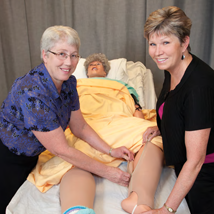
Instructor Karen Kennedy scores Lethbridge College’s first-ever patent, providing a greater reality for nursing students everywhere.
Karen Kennedy has developed an impressive resume during her nursing career: a registered nurse working in a variety of healthcare environments, and obtaining her masters in education to teach in a hospital and school setting.
But the co-ordinator of Lethbridge College’s Simulated Patient Health Environment for Research and Education (SPHERE) surprised even herself when she was recently able to add “inventor” to her list of achievements.
Soon, nursing students will be pulling her “socks” up.
“I wanted to get more involved with education. Working in simulation at the grassroots level has been a really excellent opportunity for me,” says Kennedy, part of the Lethbridge College family since 2006. “I didn’t realize how much I enjoyed teaching; it’s just a wonderful feeling.”
Kennedy, with her friend and business partner Colleen Ward, filed a patent for Simleggings, a teaching/learning product designed to zip over the ankles and lower legs of a human patient simulator, such as the one used in the SPHERE, to display pitting edema, a symptom resulting from an abnormal accumulation of fluid in body tissues. Part of the satisfaction of teaching for Kennedy is ensuring her students get the most realistic experiences possible.
Simleggings allow students to use sight and touch to understand what pitting edema is actually like. In the past, students using the SPHERE had no way to view the effects of the condition.
“Up until this point, I was using a sticky note that said, ‘pitting edema’ that I would stick on the mannequin’s leg,” she says. “But I wanted something more real.”
In addition to being used on human patient simulators, Simleggings are also being used on standardized patients,” people taught to mimic illnesses and conditions with pitting edema. Along with educational environments on mannequins and standardized patients, the leggings can also be sold to medical facilities and simulation centres. Kennedy says she has been thinking about simulating pitting edema for several years.
“I had researched some of the materials I thought would work best, but I wasn’t really sure how we were going to make it all come together,” she says. I approached my friend Colleen who was involved in teaching sewing to elementary students and asked her if she wanted a new challenge. I explained what I was trying to achieve, gave her my stash of materials and let her create.”
The two have been working on the project for almost a year and it is still ongoing.
The next step for Kennedy and Ward was completing and filing a patent application, which can be tricky. So, the duo enlisted the help of Lorne MacGregor, Lethbridge College’s director of Applied Research and Innovation, to guide them through the process. MacGregor was eager to take on the task: he’s been involved in the patent world for the last 16 years.
“I liked that Simleggings filled a real need which could lead to better educated healthcare professionals,” says MacGregor. “The concept is simple but it may save lives.”
But, he admits patenting is a lengthy process which must be pursued carefully. First, the team did extensive research to ensure no similar invention was patented. Then, a description of the product was produced in a proper patent application. Lastly, the necessary documentation was taken to a patent agent and the application was filed. Now, the team is awaiting approval.
But, Kennedy says that hasn’t stopped her from making use of Simleggings in the classroom. “Students love this form of teaching because it’s so interactive,” she says. “They have an opportunity to learn more about working in a team, and learn how to give and receive feedback. The simulations really do translate to the real world and that gives me goose bumps.”
While Kennedy and Ward have managed to sell Simleggings in Canada and the United States so far, she says it is still too early to expect much feedback from customers.
“We’ve only been selling them for the last six weeks or so, so I don’t feel that people have had the opportunity to use them enough to have any sort of reaction yet,” she said in May, adding they will be sending out a form to every purchaser in the near future to obtain feedback on the product which will guide future development.
However, they have received calls from people asking if they could manufacture something to fit over the arms, and Kennedy feels it might be an exciting avenue to pursue. “We’re looking at the best way to be able to do that,” she says.
Kennedy says this project has given her a new perspective on achieving her goals and believes if she can do it, others can too.
“If you’ve got an idea, don’t think it can’t happen,” she says. “I was kind of hesitant to move forward with this, thinking ‘what’s the big deal?’ But it has turned out to be a very interesting experience.”


